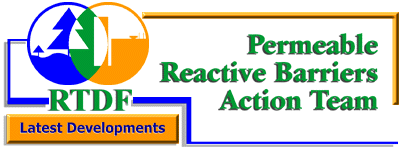 |
Chlorinated Solvents |
||||||
|
|
|
||||||
|
|
|||||||
 |
Chlorinated Solvents |
||||||
|
|
|
||||||
|
|
|||||||
|
Contaminants: Reactive Media: Construction: Point of Contact: |
|
|
Construction of a full-scale permeable reactive barrier (PRB) was completed in August 1998 at the Tonolli Superfund Site near Nesquehoning, PA. The Tonolli Corporation operated a battery recycling and secondary lead smelting plant at the site from 1974 until 1986, and currently is responsible for cleanup activities. The presence of elevated dissolved metals in the ground water is attributed to both waste sources and anthropogenic sources from the dumping of battery acid during past site operations, and the acid mine drainage effect of the mine spoils. The contamination is located in coal mine spoil at 0-19 ft and in alluvium from 74-113 ft. No information provided about the lithology between. Ground water in the area flows horizontally southeast toward Nesquehoning Creek. Vertical ground-water flow is downward in the northern portion of the site, and upward in the southern portion of the site, where it discharges to the creek. To construct the PRB, a ground-water trench, approximately 3 ft wide, 20 ft deep, and 1,100 ft long, was dug using a trackhoe. Trench boxes were installed parallel to the creek along the southern site property boundary. Results Pending (2000).
One-pass trenching equipment was evaluated and determined to be impractical. Problems arose during construction as a result of the presence of rubble and concrete foundations, sloughing of mine spoil, and the close proximity of a railroad spur and an onsite landfill embankment. In addition, the wall was designed to be 1 ft in width but required expansion to 3 ft. |
![]()
Sponsored by the Technology Innovation Program
Date Last Modified: January 14, 2000